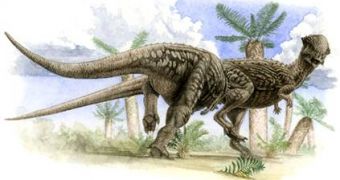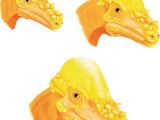They are considered the rams of the dinosaur world. But the dome-headed dinosaurs were able to batter their heads only when teenagers, to avoid brain damage, as revealed by a new research published in the Palaeontologia Electronica journal.
The pachycephalosaurs or thick-headed dinosaurs, not very large (up to 5 m (17 ft) long and 2 tons heavy), which lived 80 to 65 Ma ago during the Late Cretaceous in Asia and North America were related to duck-billed and horned dinosaurs, being plant-eaters. Their outstanding trait was the skull dome, up to 25 cm (10 in) thick. The dome varied from a bike helmet-like in Prenocephale's sloping skull to the shape of lengthy horns on the top of the skull of Stygimoloch, or just bony knobs on Stegoceras.
The research team imagined that such thick skulls were used for battering one into another like bighorn sheep, over mates, food or territory.
"Or the flashy noggins may have served as mate-bait or for visual communication," said Mark Goodwin of the University of California-Berkeley's Museum of Paleontology.
To check the ramming hypothesis, the research team made computer models of the skulls of adults and sub-adults Homalocephale colathoceros and Pachycephalosaurus wyomingensis.
The animals could dash one into another at speeds of 6.7 to 15 mph (3 to 6.7 m/s), measured based on the hip heights and limb proportions of these dinosaurs.
The resulting smash-ups provided information on the amount of force, how that stress was distributed along the skulls and ultimately the post-ramming state of the skulls.
"The highest forces we got for a large pachycephalosaur were about 14,000 Newtons, or about as much as T. rex would exert with one of its back teeth," said co-author Eric Snively of the University of Alberta, who had found in a previous research that the fused Arch-like nasal bones of the Tyrannosaurus enabled the huge carnivorous dino to bite with the power required to lift a semi-trailer without harming its skull.
But the computer simulation showed that the skull of Homalocephale couldn't fully dissipate the impact power in frontal area. "The stresses in big adults were usually far below those that would break the bone," said Snively.
But the brain could be affected.
Previous research made by Goodwin and Jack Horner of Montana State University's Museum of the Rockies revealed that in adult pachycephalosaurs, the skull dome was almost devoid of vascularization.
"We don't know how it could heal internally. Any sort of damage would be bad news," said Snively.
The sub-adults were more likely to recover after a ramming, as their skulls were endowed with radiating structures that could compress during the head butting, acting like shock absorbers. But being able to do it does not mean they did it, warn the authors. The research made by Goodwin and Horner in 2004 suggest that the adorned skulls may have been used for visual communication in social bounding or competition for mates.
"A lot of the structures that are ascribed to give these animals a biomechanical advantage are in fact a product of fast-growing bone. Once pachycephalosaurs reach adulthood, a time when head-butting behaviors would be most likely, the structures are absent. So if the structures that give an animal a biomechanical advantage are absent, then they likely didn't engage in that type of hypothesized behavior to begin with," Goodwin told LiveScience.
Proofs of head-butting skull injuries would be now the only thing to convince the researchers that pachycephalosaurs rammed.

 14 DAY TRIAL //
14 DAY TRIAL // 
